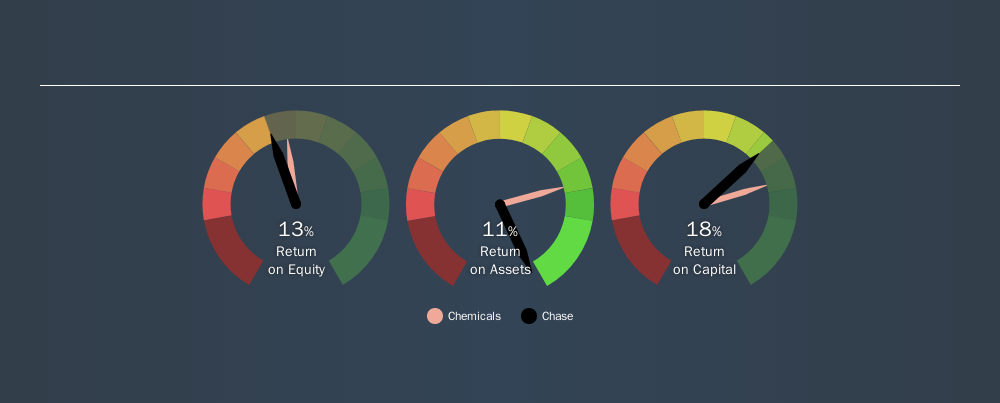- United States
- /
- Chemicals
- /
- NYSEAM:CCF
Why Chase Corporation’s (NYSEMKT:CCF) Return On Capital Employed Is Impressive

Today we'll look at Chase Corporation (NYSEMKT:CCF) and reflect on its potential as an investment. Specifically, we're going to calculate its Return On Capital Employed (ROCE), in the hopes of getting some insight into the business.
First of all, we'll work out how to calculate ROCE. Next, we'll compare it to others in its industry. And finally, we'll look at how its current liabilities are impacting its ROCE.
Return On Capital Employed (ROCE): What is it?
ROCE measures the amount of pre-tax profits a company can generate from the capital employed in its business. All else being equal, a better business will have a higher ROCE. Ultimately, it is a useful but imperfect metric. Author Edwin Whiting says to be careful when comparing the ROCE of different businesses, since 'No two businesses are exactly alike.'
So, How Do We Calculate ROCE?
The formula for calculating the return on capital employed is:
Return on Capital Employed = Earnings Before Interest and Tax (EBIT) ÷ (Total Assets - Current Liabilities)
Or for Chase:
0.18 = US$49m ÷ (US$300m - US$23m) (Based on the trailing twelve months to May 2019.)
Therefore, Chase has an ROCE of 18%.
See our latest analysis for Chase
Does Chase Have A Good ROCE?
One way to assess ROCE is to compare similar companies. In our analysis, Chase's ROCE is meaningfully higher than the 10% average in the Chemicals industry. We consider this a positive sign, because it suggests it uses capital more efficiently than similar companies. Regardless of where Chase sits next to its industry, its ROCE in absolute terms appears satisfactory, and this company could be worth a closer look.

Remember that this metric is backwards looking - it shows what has happened in the past, and does not accurately predict the future. Companies in cyclical industries can be difficult to understand using ROCE, as returns typically look high during boom times, and low during busts. This is because ROCE only looks at one year, instead of considering returns across a whole cycle. How cyclical is Chase? You can see for yourself by looking at this free graph of past earnings, revenue and cash flow.
Chase's Current Liabilities And Their Impact On Its ROCE
Current liabilities include invoices, such as supplier payments, short-term debt, or a tax bill, that need to be paid within 12 months. Due to the way ROCE is calculated, a high level of current liabilities makes a company look as though it has less capital employed, and thus can (sometimes unfairly) boost the ROCE. To counter this, investors can check if a company has high current liabilities relative to total assets.
Chase has total liabilities of US$23m and total assets of US$300m. As a result, its current liabilities are equal to approximately 7.6% of its total assets. In addition to low current liabilities (making a negligible impact on ROCE), Chase earns a sound return on capital employed.
Our Take On Chase's ROCE
If it is able to keep this up, Chase could be attractive. There might be better investments than Chase out there, but you will have to work hard to find them . These promising businesses with rapidly growing earnings might be right up your alley.
For those who like to find winning investments this free list of growing companies with recent insider purchasing, could be just the ticket.
We aim to bring you long-term focused research analysis driven by fundamental data. Note that our analysis may not factor in the latest price-sensitive company announcements or qualitative material.
If you spot an error that warrants correction, please contact the editor at editorial-team@simplywallst.com. This article by Simply Wall St is general in nature. It does not constitute a recommendation to buy or sell any stock, and does not take account of your objectives, or your financial situation. Simply Wall St has no position in the stocks mentioned. Thank you for reading.
About NYSEAM:CCF
Chase
Chase Corporation, a specialty chemicals company, engages in the manufacture and sale of protective materials for various applications in North America, Asia, the Middle East, Europe, and internationally.
Excellent balance sheet and slightly overvalued.
Similar Companies
Market Insights
Community Narratives





